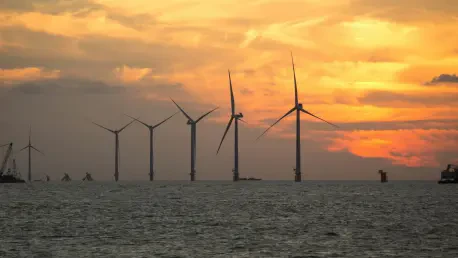In a world increasingly focused on sustainable energy solutions, Dominion Energy is at the forefront of a transformative project that could redefine power generation along the Atlantic Coast with its Coastal Virginia Offshore Wind (CVOW) initiative. This staggering 2.6-gigawatt wind farm, situated off Virginia’s shores, stands as one of the largest offshore wind projects in the United States. This ambitious undertaking is not just about harnessing the power of the wind; it’s a bold statement of intent to reduce carbon emissions and meet growing energy demands with clean, renewable resources. As Dominion Energy navigates complex financial, operational, and policy landscapes, the CVOW project serves as a critical case study in how utility companies can balance innovation with practicality. This exploration delves into the multifaceted efforts behind the project, shedding light on timelines, challenges, and strategic responses that position Dominion as a leader in the renewable energy sector, paving the way for a greener future.
A Vision for Renewable Power
Dominion Energy’s commitment to renewable energy is vividly embodied in the CVOW project, which promises to deliver substantial clean power to Virginia’s grid by the end of 2026. Spearheaded by President, CEO, and Chairman Bob Blue, the initiative has maintained a steady trajectory despite external pressures, as highlighted in a recent earnings call on August 4. With a capacity of 2.6 gigawatts, this offshore wind farm is poised to become a cornerstone of the state’s energy infrastructure, supporting both environmental goals and energy security. The project’s scale underscores a broader shift toward sustainable power generation in the U.S., where offshore wind is increasingly seen as a viable solution to meet rising demand without the carbon footprint of traditional fossil fuels. Dominion’s focus on this massive undertaking reflects a strategic vision to lead in the clean energy transition, setting a precedent for other utilities to follow in tackling the complexities of large-scale renewable projects with determination and foresight.
The significance of CVOW extends beyond its immediate impact on Virginia, representing a national benchmark for offshore wind development. This project is not merely about generating power; it’s about proving that renewable energy can be scaled effectively to replace older, less sustainable systems. Dominion Energy has positioned itself as a pioneer by committing to a timeline that ensures completion within the next two years, aligning with broader federal and state goals for carbon reduction. The emphasis on maintaining this schedule, as reiterated by leadership, demonstrates a proactive approach to project management, ensuring that delays are minimized even in the face of unforeseen challenges. By prioritizing this initiative, Dominion is also contributing to job creation and economic growth in the region, fostering a ripple effect that benefits local communities. This holistic approach to energy development highlights how CVOW is more than a technical achievement—it’s a catalyst for systemic change in how energy is produced and consumed.
Financial Hurdles and Strategic Mitigation
The financial landscape for the CVOW project has grown more challenging due to recent trade policies that have introduced significant cost increases through tariffs. These measures have driven up expenses by $506 million, pushing the total budget to a hefty $10.9 billion, with the potential for an additional $134 million burden from proposed tariffs on imports from Mexico and the European Union. Despite these daunting figures, Dominion Energy has taken decisive steps to cushion the impact through close collaboration with vendors and detailed analysis of trade regulations. Remarkably, the cost increase translates to a negligible average rise of just three cents per month on customer bills over the project’s lifespan. This minimal impact on ratepayers reflects a deliberate effort to maintain affordability, ensuring that the transition to clean energy does not come at an unreasonable cost to consumers, while still addressing the financial pressures head-on with pragmatic solutions.
Beyond the immediate tariff challenges, Dominion Energy’s financial strategy for CVOW showcases a broader commitment to balancing innovation with economic responsibility. The ability to mitigate over half a billion dollars in added costs without passing a significant burden onto customers speaks to a sophisticated approach to budget management. Leadership has emphasized transparency in communicating these impacts, framing the project as one of the most cost-effective energy sources for Virginia’s residents. This framing is crucial in maintaining public support for renewable initiatives, especially in an era where energy costs are a sensitive topic. Additionally, the proactive engagement with regulatory frameworks to offset tariff effects demonstrates a forward-thinking mindset, ensuring that financial obstacles do not derail the project’s momentum. As Dominion navigates this complex economic terrain, the focus remains on delivering value to both shareholders and the community, reinforcing trust in the utility’s ability to manage large-scale renewable endeavors.
Operational Progress and Technical Innovation
On the operational front, Dominion Energy is making impressive strides with the CVOW project, achieving milestones that set it apart in the U.S. offshore wind sector. As of the latest updates, 76% of the 176 monopiles—essential foundational structures for the wind turbines—have been successfully installed, alongside the completion of all pin piles. This rapid pace of construction surpasses other domestic offshore wind initiatives, reflecting a high level of technical expertise and logistical coordination. The first turbine installation is on track for September, aligning with the original timeline and signaling that Dominion is well-positioned to meet its ambitious 2026 completion goal. These achievements are a testament to the company’s dedication to operational excellence, ensuring that the physical infrastructure of CVOW is progressing at a rate that matches its visionary scope, while overcoming the inherent difficulties of offshore construction.
Innovation plays a pivotal role in Dominion’s operational strategy, particularly with the development of Charybdis, the first Jones Act-compliant offshore wind turbine installation vessel. Although a delay in the vessel’s readiness due to internal communication technology issues has slightly pushed back early turbine installations, the $715 million investment remains unchanged. Originally set for sea trials in July, the vessel’s completion is now slightly behind schedule, but once operational, it will significantly enhance efficiency by eliminating the reliance on barges for turbine installation. This move not only streamlines the construction process but also aligns with national goals to bolster domestic manufacturing and compliance with federal regulations. The integration of such cutting-edge solutions underscores Dominion’s commitment to leveraging technology to overcome logistical challenges, ensuring that CVOW remains at the forefront of offshore wind development through both progress and adaptability.
Policy Navigation and Future Security
Dominion Energy’s ability to navigate a shifting policy landscape is a critical factor in the CVOW project’s ongoing success. Despite legislative changes, such as the One Big Beautiful Bill Act, which modified certain renewable energy incentives, the company remains confident in securing tax credits under the Inflation Reduction Act. Through safe harbor provisions and adherence to established rules, leadership anticipates preserving all forecasted credits for CVOW, with only a small fraction of clean energy projects requiring active mitigation. This strategic planning highlights a deep understanding of regulatory dynamics, ensuring that financial benefits tied to federal incentives are safeguarded. By proactively addressing potential policy disruptions, Dominion demonstrates resilience, positioning the project to weather uncertainties while maintaining its commitment to delivering clean energy on schedule.
The broader implications of Dominion’s policy strategy extend to how it shapes public and political perceptions of offshore wind projects. By securing incentives and mitigating risks associated with legislative shifts, the company reinforces the viability of renewable energy as a stable investment. This approach is particularly significant in an environment where trade policies and tariff increases pose ongoing threats to project budgets. Leadership’s emphasis on maintaining financial stability through careful navigation of these incentives reflects a nuanced balance between compliance and advocacy for supportive clean energy policies. Furthermore, the minimal impact on customer bills, despite policy-driven cost hikes, serves as a powerful message that renewable projects can remain affordable. As Dominion continues to adapt to regulatory changes, the CVOW project stands as a model of how utilities can align with national clean energy goals while managing the intricacies of policy fluctuations with precision and foresight.
Shaping a Sustainable Legacy
Looking back, Dominion Energy’s journey with the Coastal Virginia Offshore Wind project showcases a remarkable blend of ambition and adaptability in the face of daunting challenges. The company tackled a $506 million cost increase from tariffs, with potential additional expenses of $134 million, yet managed to limit the impact on customers to a mere three cents per month on average. Construction achievements, like installing 76% of monopiles at a record-setting pace, highlighted operational excellence, while innovations such as the Charybdis vessel pointed to a future of enhanced efficiency. Policy hurdles were met with strategic planning to secure vital tax credits, ensuring financial stability.
Moving forward, the focus should be on sustaining this momentum by fostering stronger vendor partnerships to further mitigate costs and advocating for stable clean energy policies at the federal level. Dominion’s success with CVOW could inspire other utilities to pursue offshore wind with confidence, provided lessons on balancing affordability and innovation are applied. As the project nears its 2026 completion, it lays a foundation for scalable renewable solutions, urging stakeholders to prioritize long-term investments in infrastructure and technology that support a cleaner, more resilient energy grid for future generations.









